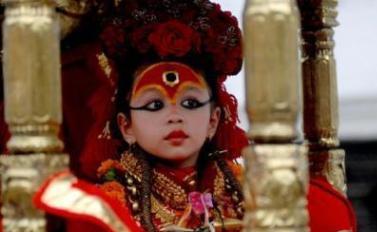Nepal, being home to some hundred ethnic groups, is not only a country famous for mountains but also for its diverse culture and festivals.

Down the ages, Nepal has been seen as a mysterious land with many gods, goddess, deities and manifestations, which are worshipped. Apart from all these, Nepal also has a tradition of a ‘real’ living goddess.
The Kumari Devi is a young girl who lives in the building known as the Kumari Ghar in Kathmandu. The literal meaning of Kumari is ‘virgin’. It is believed that the Kumaris are young pre-pubescent girls who receive the power of Goddess Taleju (Durga) who symbolizes power and protection.Since the 13th century, the Newars of the Kathmandu Valley have been worshiping goddess Kumari in the most unique form — that is, worshiping a girl child as the goddess, or as a living embodiment of those Hindu goddesses.
There are numerous tales regarding the history and origin of Goddess Kumari. Among the few, one concerning the King and Goddess Taleju are widespread. Jaya Prakash Malla, was the last king of the Malla Dynasty. According to the legend, Goddess Taleju visited Jaya Prakash Malla’s chambers during night time as a beautiful woman. They would play Tripasa (a dice game). One night, the king made sexual advances towards the Goddess and infuriated her. As punishment, Goddess stopped visiting the King’s place. He worshipped and pleaded for her return. Later, Goddess Taleju agreed to appear in the body of a virgin girl from the Shakya family. Hence, the Kumari Goddess trend was established.
The Newar Shakya and Bajracharya caste are Buddhists. The girl who is going to be selected as the Goddess Kumari is born in a Buddhist family and becomes a Hindu deity. So, Nepal is considered to be the meeting point of Buddhism and Hinduism.
A Kumari’s glance is believed to bring good fortune. Many people visit the courtyard in front of Kumari’s window to get a glimpse of the living goddess. Most of the people who visit her are those suffering from illness and menstrual disorders. It is believed that Kumari has special powers over such maladies.
To become a Kumari, children have to go through a rigorous selection process which is vast and have certain strict criteria. Some basic characteristics searched in children are sound health, no evidence of scars and marks on the body, pre-menstrual and no loss of teeth and blood. The child also should not be afraid of blood and masked man but if she shows any signs of fear then she is not worthy of Goddess Taleju’s power.
The girl has to show calm and fearlessness and her horoscope is checked to make sure that it is favorable to the king’s horoscope. The selection process of Kumari is tough. She has to go through numerous tasks, after the accomplishment of the all tasks by the selected girl the spirit of Goddess Taleju is installed in the girl by the priest and she becomes the Goddess Kumari and resides in Kumari Mahal built by Jaya Prakash Malla in 1757 until her menstruation or the first cut and bleeding.
The Kumari Jatra (Festival) is celebrated every year in the month of September.
Kumari Goddess is the human symbol of power and protection. She is the sole embodiment of pureness among Hindu and Buddhist followers. After the Kumari enters her adolescence and begins her first menstruation, she is considered impure, and the search for a new Kumari starts.
Life of the Kumari in the four walls of ‘Kumari Ghar’ is not so easy to live, they have to follow strict rules and lead a disciplined life. She is not allowed to go out of the Kumari ghar except on special occasions. The Kumari is not even aware of the outer world. Somehow in the race of becoming a Kumari, her childhood is lost somewhere. Leading a royal life for years and suddenly thrown back to normal life can psychologically damages the child’s mind. There is also a myth about of how a Kumari’s spouse will die early leading to the now ‘normal’ girl never getting married.
However, many human rights and children rights activists have come forward and pressurised the government to remove strict rules imposed on Kumaris as they were not given proper education and knowledge about social life.
But now many things have changed, Kumaris in the Kumari ghar are provided with personal tutor and education. Now they have access to Internet, books, and magazines. There is a step towards a better future of Kumari Goddess after they lose the title of ‘living goddess’.
————-author ————————————————————
Shradha Chhetry


If I understand the traditional ways correctly, there are three Kumari goddesses. It would be nice if the author could enlighten us.